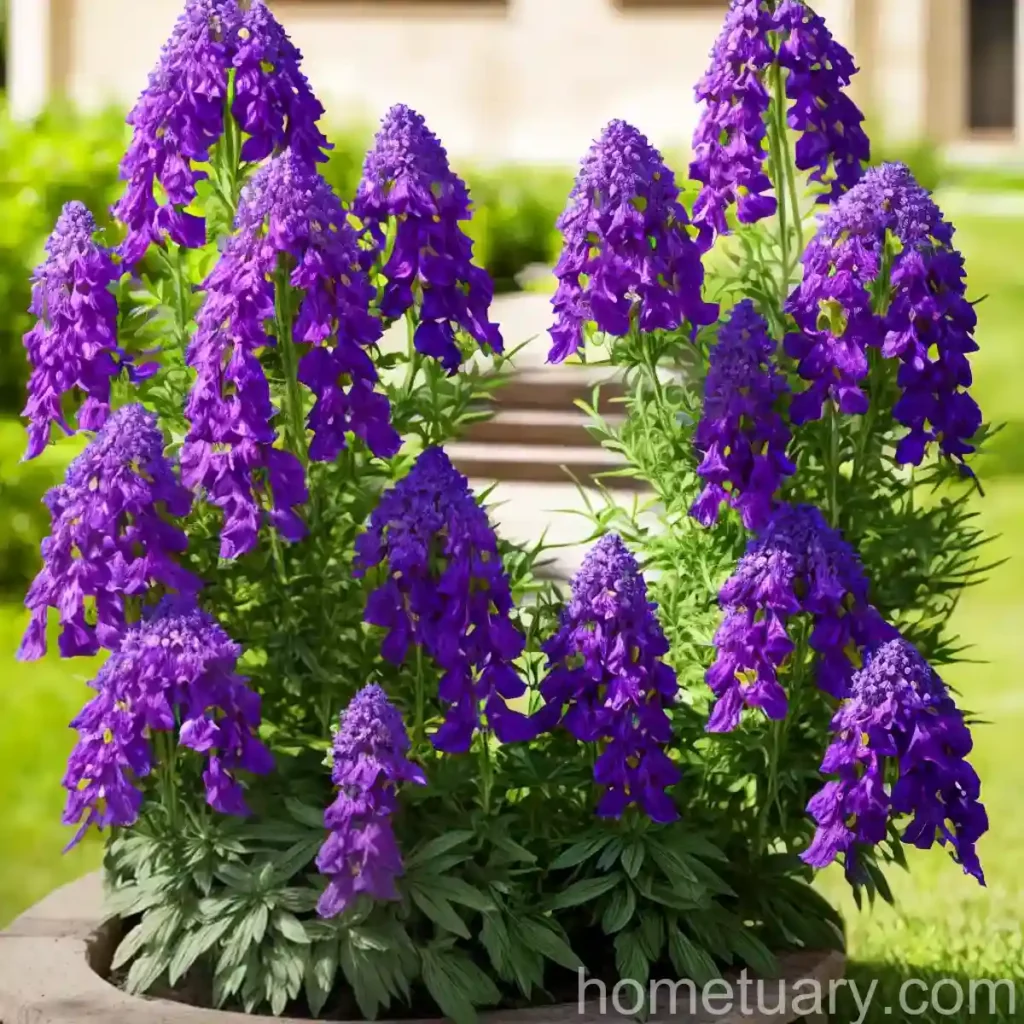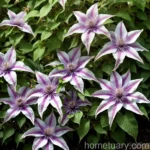Giant Larkspur (Consolida ajacis): A Comprehensive Guide
The world of plants is both diverse and fascinating, and within this world, the giant larkspur (Consolida ajacis) stands out as a charming and elegant flowering plant. Its unique characteristics and stunning blooms make it a favorite among gardeners and plant enthusiasts. In this detailed guide, we will explore all aspects of the giant larkspur, from its description and cultivation to its uses, symbolism, and maintenance.
What is the Giant Larkspur (Consolida ajacis)?
The giant larkspur, scientifically known as Consolida ajacis, belongs to the Ranunculaceae family and is native to Western Asia and Europe. It is a popular annual plant that produces tall spikes of vividly colored flowers, making it a desirable addition to gardens and landscapes. The plant derives its common name, “larkspur,” from the spur-like formation of the flower petals. With its delicate and showy blossoms, the giant larkspur is often utilized in floral arrangements and adds a touch of elegance to any setting.
Key Takeaways – Giant Larkspur (Consolida ajacis)
Before delving into the specifics of growing and caring for the giant larkspur, let’s take a closer look at some key takeaways associated with this beautiful plant:
-
Giant Larkspur Benefits: Offers a stunning display of colorful blossoms, attracts pollinators, and serves as an excellent cut flower for floral arrangements.
-
Consolida ajacis Description: Tall spikes of flowers in various hues, with a characteristic spur-like formation, and finely cut, feathery foliage.
-
Growing Giant Larkspur: Requires well-drained soil, ample sunlight, and regular watering; suitable for both garden beds and containers.
-
Consolida ajacis Care Tips: Regular deadheading, adequate spacing, and proper staking can promote healthy growth and prolonged bloom.
-
Giant Larkspur Varieties: Available in a range of colors, including blue, pink, purple, and white, offering options for diverse garden designs.
-
Consolida ajacis Facts: Known for its toxicity to humans and animals, requiring caution in handling and planting in areas accessible to pets and children.
Now that we have an overview of the key points, let’s delve deeper into the various aspects of cultivating and caring for giant larkspur, as well as understanding its significance and potential challenges.
Culture
Cultivating the giant larkspur involves understanding its specific cultural needs, including requirements for water, sunlight, soil, and fertilizer. By providing the right environment and care, you can ensure that the plant thrives and displays its characteristic beautiful blooms.
Uses
Before exploring the cultural requirements in detail, it’s essential to appreciate the multiple uses of giant larkspur:
- Ornamental Plant: Admired for its tall spikes of colorful flowers, making it an attractive choice for garden borders and cutting gardens.
- Floral Design: Often used in floral arrangements due to its striking and long-lasting blooms, adding elegance and height to bouquets.
- Wildlife Attraction: Attracts pollinators such as bees and butterflies, contributing to the overall biodiversity of the garden.
Water
Proper watering is crucial for the healthy growth and blooming of giant larkspur. Understanding the water needs of this plant is essential to prevent issues such as wilting, stunted growth, or poor flower production.
Water Needs:
– Initial Establishment: During the initial growth phase, the plants should receive consistent moisture to aid in root development and establishment. Water deeply once or twice a week, depending on rainfall and soil moisture levels.
– Blooming Period: As the plants enter their blooming phase, it’s important to maintain even moisture to support the production of vibrant flowers. This typically requires regular watering, especially during dry spells, to prevent the soil from drying out.
Overwatering should be avoided, as it can lead to root rot and other water-related issues. Consistently moist, well-drained soil is the ideal condition for giant larkspur.
Sunlight
The giant larkspur thrives in full sun conditions, requiring ample sunlight to promote robust growth and prolific flowering. When selecting a planting site or container for the larkspur, it’s essential to consider the availability of sunlight throughout the day.
Sun Requirements:
– Full Sun: Plant the giant larkspur in an area that receives at least 6-8 hours of direct sunlight daily. Insufficient sunlight may lead to leggy growth and reduced flowering.
– Partially Shaded Areas: While the plant can tolerate some light shade, it thrives best in full sun conditions, producing the most impressive blooms and maintaining a compact, sturdy form.
Adequate sunlight is integral to the overall health and vigor of giant larkspur, contributing to the production of abundant and vibrant flowers.
Fertilizer
Fertilization plays a crucial role in providing the necessary nutrients for healthy growth and optimal blooming. Understanding the appropriate fertilization regimen can ensure that the giant larkspur receives the essential elements for robust and vigorous development.
Fertilizer Application:
– Balanced Fertilizer: Use a balanced, all-purpose fertilizer with an NPK ratio of 10-10-10 or similar formulation to provide a steady supply of nutrients.
– Timing: Apply fertilizer when planting and again as the plants establish and initiate flowering. A light application of a balanced fertilizer can promote strong, healthy growth without excessive vegetative development.
– Avoid Overfeeding: Refrain from over-fertilizing, as excessive nitrogen can lead to overly lush foliage at the expense of flower production. Follow the recommended application rates for the specific fertilizer product used.
By providing appropriate nourishment through regular fertilization, you can support the giant larkspur’s growth and enhance its capacity for abundant flowering.
Soil
Understanding the soil requirements of the giant larkspur is essential for creating an optimal growing environment. The right soil composition and structure can contribute to the plants’ overall health and vitality, influencing their ability to thrive and produce striking blooms.
Soil Type:
– Well-Drained Soil: Plant giant larkspur in well-drained soil to prevent waterlogging and soil saturation, which can lead to root rot and other moisture-related issues.
– Loose and Fertile: Choose a soil that is loose, fertile, and rich in organic matter to provide adequate nutrition and support healthy root development.
– pH Level: The ideal soil pH for giant larkspur ranges from slightly acidic to neutral (pH 6.0-7.0), promoting nutrient availability and optimal physiological processes within the plant.
Amending the soil with organic matter, such as compost or well-rotted manure, can enhance its structure and fertility, providing an ideal medium for the growth of giant larkspur.
Pruning
Pruning is an important aspect of giant larkspur maintenance, contributing to the plant’s overall appearance, vigor, and longevity. By employing proper pruning techniques, you can enhance the plant’s aesthetic value and reduce the likelihood of disease or pest infestations.
Pruning Guidelines:
– Deadheading: Regularly remove spent flowers to encourage continuous blooming and prevent the formation of seed pods, redirecting the plant’s energy towards new flower production.
– Thinning: If the plants become overcrowded or excessively dense, consider thinning them to improve air circulation and reduce the risk of disease.
– Staking: In cases of tall or top-heavy growth, provide support with stakes to prevent bending or breakage, especially in areas with strong winds.
Pruning should be performed with sharp, clean tools to minimize damage to the plant and reduce the risk of disease transmission. Proper pruning techniques contribute to the overall health and appearance of giant larkspur.
Propagation
The propagation of giant larkspur allows for the expansion of plant populations and the creation of new displays of its captivating blooms. Understanding the various methods of propagation can enable gardeners to multiply their larkspur plants and diversify their garden collections.
Propagation Methods:
– Seed Propagation: Giant larkspur can be propagated from seeds sown directly in the ground or started indoors and later transplanted. Seeds typically germinate within 10-15 days when provided with suitable conditions.
-
Division: While less common, giant larkspur can also be propagated by division, particularly if the plants become overcrowded and need to be separated for better growth.
-
Cuttings: Propagation via stem cuttings is possible, though it is less frequently employed due to the ease and reliability of seed propagation.
By employing suitable propagation methods, you can expand your collection of giant larkspur plants and ensure a continuous display of their stunning flowers.
Container Popularity
Giant larkspur is a popular choice for container gardening due to its striking vertical growth and vibrant blooms. When selected for container cultivation, several considerations must be addressed to ensure the plants’ success and longevity in a confined environment.
Container Considerations:
– Size: Choose a sufficiently large container to accommodate the mature size of the giant larkspur, providing ample space for root development and stability.
– Drainage: Ensure that the container has adequate drainage holes to prevent waterlogging and maintain optimal soil moisture levels.
– Soil: Utilize a well-draining, fertile soil mix suitable for container gardening, incorporating organic matter to enhance nutrient retention and soil structure.
By selecting appropriate containers and addressing the specific needs of giant larkspur in container cultivation, you can enjoy the beauty of these plants on patios, balconies, and other confined spaces.
Common Diseases
While giant larkspur is generally resilient, it is susceptible to certain diseases that can affect its overall health and vigor. Recognizing common diseases and understanding their prevention and treatment is essential for maintaining robust, disease-free plants.
Disease Diagnosis
The following are some common diseases that may affect giant larkspur and their diagnostic features:
-
Powdery Mildew: Appears as a white, powdery coating on leaves and stems, affecting plant vigor and appearance. Often exacerbated by high humidity and poor air circulation.
-
Botrytis Blight: Causes brown spots and rot on flowers and foliage, particularly in wet and humid conditions. Infected plant parts may display characteristic fuzzy gray mold.
-
Leaf Spot: Characterized by the development of dark spots or lesions on the leaves, potentially leading to defoliation and reduced photosynthetic capacity.
Prompt identification and intervention can prevent the spread of diseases and minimize their impact on giant larkspur plants.
Common Pests
In addition to diseases, giant larkspur may also encounter various pest pressures that can compromise its health and vitality. Recognizing common pests and implementing effective pest control measures is crucial for safeguarding the plants against infestations.
Botanist’s Tips
As a botanist, I have some valuable tips to share for the successful cultivation and care of giant larkspur:
-
Hummingbird Attraction: Giant larkspur’s flowers are known to attract hummingbirds, making them a valuable addition to wildlife-friendly garden designs.
-
Caution with Children and Pets: Due to its toxic properties, it’s important to exercise caution when planting and handling giant larkspur, ensuring it is placed out of reach of children and pets.
-
Companion Planting: Consider planting giant larkspur alongside other sun-loving perennials and annuals with similar cultural requirements to create visually appealing garden displays.
Fun Facts
Here are some fascinating fun facts about giant larkspur and its unique characteristics:
- Historical Significance: Larkspur flowers have been used in various cultures for their symbolic meanings, often associated with a light-hearted disposition and an open heart.
- Symbolism: In the language of flowers, blue larkspur represents an open heart and ardent attachment, while pink larkspur symbolizes fickleness and white larkspur signifies a happy nature.
- Cultural Uses: The flowers of giant larkspur have been utilized in traditional medicine for their potential medicinal properties, though caution is advised due to their toxicity.
Links to External Resources
- Royal Horticultural Society – Consolida ajacis
- Missouri Botanical Garden – Consolida ajacis
- North Carolina State University Extension – Growing Larkspur
- The Old Farmer’s Almanac – Larkspur Planting Guide
- University of California Integrated Pest Management Program – Larkspur Diseases
Conclusion
In conclusion, the giant larkspur (Consolida ajacis) is a captivating flowering plant that offers an array of stunning blooms, cultural significance, and wildlife appeal. By understanding its specific requirements for water, sunlight, soil, and care, gardeners can cultivate and enjoy the beauty of this charming plant. From its ornamental uses to its historical symbolism and potential challenges, the giant larkspur presents a wealth of opportunities for horticultural enthusiasts. By following the guidelines provided in this comprehensive guide, individuals can confidently grow and appreciate the allure of the giant larkspur in their gardens and landscapes.















